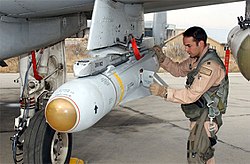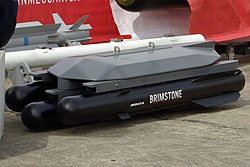Air-to-surface missile
| This article does not cite any references or sources. (December 2009) |
An air-to-surface missile (ASM) or air-to-ground missile (AGM or ATGM) is a missile designed to be launched from military aircraft (bombers, attack aircraft, fighter aircraft or other kinds) and strike ground targets on land, at sea, or both. They are similar to guided glide bombs but to be deemed a missile, they usually contain some kind of propulsion system. The two most common propulsion systems for air-to-surface missiles are rocket motors and jet engines. These also tend to correspond to the range of the missiles — short and long, respectively. Some Soviet air-to-surface missiles are powered by ramjets, giving them both long range and high speed.
Guidance for air-to-surface missiles is typically via laser guidance, infrared guidance, optical guidance or via GPS signals. The type of guidance depends on the type of target. Ships, for example, may be detected via passive or active radar, while this would not work very well against land targets which typically do not contain such a large mass of metal surrounded by empty space.
There is some cross-over between air-to-surface missiles and surface-to-surface missiles. For example, there was an air-launched version of the Tomahawk missile, although this has been superseded by the AGM-86 ALCM. Other missiles used in both roles include the Penguin anti-ship missile and AGM-84 Harpoon anti-ship missile. Many air-to-surface missiles can be used against both ships and land targets, although some of them have to be modified to perform both roles effectively. For example, the Standoff Land Attack Missile is a land-attack version of the Harpoon.
One of the major advantages of air-to-surface missiles over other weapons available for aircraft to use to attack ground targets is the standoff distance they provide. This allows them to launch the weapons outside the most intense air defences around the target site. Most air-to-surface missiles are fire-and-forget in order to take most advantage of the standoff distance — they allow the launching platform to turn away after launch. Some missiles have enough range to be launched over the horizon. These missiles (typically either cruise or anti-ship missiles) need to be able to find and home in on the target autonomously.
Sub-categories of air-to-surface missiles include:
- air-launched anti-tank guided missiles (typically launched from helicopters)
- air-launched cruise missiles
- air-launched anti-ship missiles
- anti-radiation missiles
Typically, the higher and faster the launching aircraft is flying, the further away the missile's target can be. For long range missiles this difference can be small, but short range missiles (like the AGM-65 Maverick) often dramatically increase in range when launched at altitude.
There have been examples of air-launched ballistic missiles, but they are rare. Sometimes air-to-surface missiles are divided into the categories of tactical and strategic. Typically this indicates conventional explosive or small nuclear warhead (tactical) and large nuclear warhead (strategic).
Contents |
[edit] List of air-to-surface missiles
[edit] Argentina
[edit] Brazil
- MAR-1 Anti-radiation missile
- FOG-MPM Fiber Optics Guided Multiple Purpose Missile.
- AVMT-300 Cruise missile.
[edit] China
- DH-10
- KD-88
- KD-63
- YJ-7 (C-701)
- C-704
- C-705
- FL-10
- CF-1 (Chang Feng 1)
- CF-2 (Chang Feng 2)
- FL-9
- FL-8
- FL-7
- TL-6
- TL-10
- YJ-12
- YJ-22
- YJ-62
- YJ-91
- C-805
- YJ-83 (C-803)
- C-802
- C-801
- C-101
- C-611
- HY series
- SY series
- FL series
- C-601
- YJ-63
- HN-1
- HN-3
- HN-2
- HJ-10
- HJ-9
- HJ-8
- HJ-73
- ETC...
[edit] France
[edit] Germany
- Taurus KEPD 350
- AGM Armiger
- PARS-3
- Euromissile HOT
- AS.34 Kormoran
- RBS 15 (in cooperation with Sweden)
[edit] India
AGNI-1 AGNI-2 AGNI-3 AGNI-5
[edit] Iran
[edit] Norway
[edit] Pakistan
[edit] South Africa
[edit] Sweden
[edit] Turkey
[edit] UK
- Blue Steel missile
- Brimstone missile
- Green Cheese missile (canceled in 1956)
- ALARM
- Storm Shadow
- BAe Sea Eagle
- GAM-87 Skybolt (air-launched ballistic missile; canceled)
[edit] USA
- AGM-12 Bullpup (no longer in service)
- AGM-22 (project ceased in 1980s, still in limited use)
- AGM-28 Hound Dog (no longer in service)
- AGM-45 Shrike (no longer in service)
- AGM-53 Condor (project cancelled)
- AGM-62 Walleye (no longer in service)
- AGM-63 (project cancelled)
- AGM-64 Hornet (project cancelled)
- AGM-65 Maverick (in service)
- AGM-69 SRAM (no longer in service)
- AGM-76 Falcon (project cancelled)
- AGM-78 Standard ARM (no longer in service)
- AGM-79 Blue Eye (project cancelled)
- AGM-80 Viper (project cancelled)
- AGM-83 Bulldog (project cancelled)
- AGM-84 Harpoon (in service)
- AGM-86 CALCM (in service)
- AGM-87 Focus (no longer in service)
- AGM-88 HARM (in service)
- AGM-112 (reserved when program renamed GBU-15)
- AGM-114 Hellfire (in service)
- AGM-119 Penguin (in service)
- AGM-122 Sidearm (no longer in service)
- AGM-123 Skipper (in service)
- AGM-124 Wasp (project cancelled)
- AGM-129 ACM (in service)
- AGM-130 (in service)
- AGM-131 SRAM II (project cancelled)
- AGM-136 Tacit Rainbow (project cancelled)
- AGM-137 TSSAM (project cancelled)
- AGM-142 Have Nap (in service)
- AGM-153 (project cancelled)
- AGM-154 JSOW (in service)
- AGM-158 JASSM (in development)
- AGM-159 JASSM (project cancelled)
- GAM-87 Skybolt (air-launched ballistic missile; project cancelled)
[edit] USSR/Russia
- AS-1 'Kennel' (KS-1 Kometa)
- AS-2 'Kipper' (K-10S Yen)
- AS-3 'Kangaroo' (H-20)
- AS-4 'Kitchen' (H-22 Burya)
- AS-5 'Kelt' (H-11/KSR-2)
- AS-6 'Kingfish' (H-26/KSR-5)
- AS-7 'Kerry' (H-66, H-23 Grom)
- AS-8 (9M114V Sturm-V)
- AS-9 'Kyle' (H-28)
- AS-10 'Karen' (H-25)
- AS-11 'Kilter' (H-58 Izdeliye)
- AS-12 'Kegler' (H-25MP, H-27PS)
- AS-13 'Kingbolt' (H-59 Ovod)
- AS-14 'Kedge' (H-29)
- AS-15 'Kent' (H-55/H-65S Izdeliye)
- AS-16 'Kickback' (H-15)
- AS-17 'Krypton' (H-31)
- AS-18 Kazoo (H-59M Ovod-M)
- AS-19 'Koala' (P-750 Grom)
- AS-X-19 'Koala' (3M25A Meteorit-A)
- AS-20 'Kayak' (H-35/H-37 Uran)
- AS-X-21 (Kh-90 Gela)
[edit] See also more missiles
- Surface-to-air missile
- Laser-guided bomb
- Anti-tank guided missile
- Anti-ship missile
- Cruise missile
- Anti-radiation missile
- Anti-surface warfare
- Air-to-ground weaponry
|
||||||||||||||||||||||||||||||||||||||||||||||||||||


